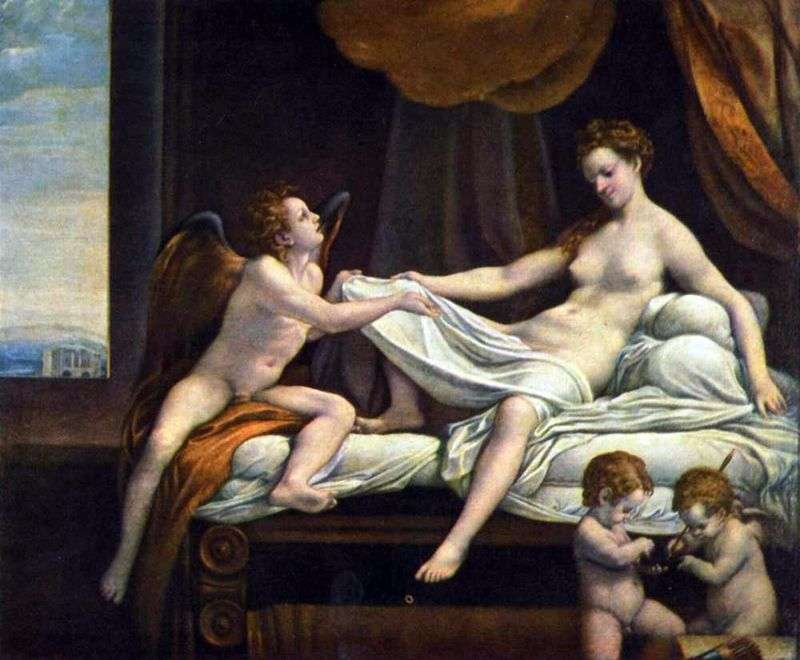
I: \ kartiny \ correggio \ 30danae. html The long time the life of this great artist was little known, and therefore filled with such incredible and opposite to each other fictions that even something in between them could not be chosen. It was believed that he did not study painting and even did not even think of being a painter. But one day, seeing in Bologna a picture of Raphael “The Holy Cecilia,” Correggio allegedly exclaimed: “Anchio sono pittore!” . From this moment he began to zealously engage in drawing art.
Other historians reject this case as a fable and argue that Correggio studied with Bianchi. According to them, he did not leave his native town of Correggio near Modena, he was neither in Rome, nor in Venice, nor in Bologna. True, this fact is also subject to doubt, since the artist’s paintings show a profound study of antiques and great paintings, which were not yet in Modena.
Still others say that Correggio was so poor and so little paid for his works that once, after receiving in Parma only 200 copper francs, he was so in a hurry to deliver them to his family that on his way home he died from exhaustion. However, in his notes Orlandi testifies that Correggio “was not a poor man and belonged to a good family name, received a good upbringing, in his youth thoroughly studied music, poetry, painting and sculpture.”
These are contradictory information about Correggio – the artist, whose works are marked with the seal of the genius of the extraordinary, and the charm and tenderness of his brush are simply amazing. Few surpassed him in the mysteries of chiaroscuro, by his division of light he produces an incomprehensible action, attracting the viewer first to the main subject, and then forcing him to rest on the setting.
The wonderful brush Correggio involuntarily makes you forget and do not see those flaws that are only visible to specialists. But in the pictures of Correggio there is always a joyful excitement that constantly accompanies the play of his creative imagination and captivates the viewer. When an artist turns to the image of a naked female body, his works become a real anthem of female beauty and grace.
In the aesthetic lexicon of the Renaissance, “grace” is a very capacious concept, with a multitude of all sorts of semantic nuances. “Grace” is not just what is commonly called “grace” in everyday life. It is only partly a synonym and “beauty”, although it is very closely related to it. As Marsilio Fachino wrote, “Beauty is a kind of charm, alive and spiritual, poured by the radiant ray of God first into the angel, then into the souls of people, into the shapes of bodies and sounds… It sweetens our souls and ignites them with ardent love.” Count B. Castiglione, friend and patron of the great Raphael, understood “grace” as an innate, heavenly gift of grace and the ability to act in accordance with this feeling.
It is to the number of such “graceful” works that the picture of Correggio “Danae” belongs, which has long enjoyed world fame. The plot for the picture the artist borrowed from Greek mythology.
At the Argosite king, Akrisia was the daughter of Danae, famous for her unearthly beauty. Akrisia was predicted by the oracle that he would perish at the hands of his son Danai. To avoid such a fate, Acrisius built vast under the ground of bronze and stone vast chambers and there he concluded his daughter. But the thunderer Zeus fell in love with her, penetrated into the underground chambers of Danai in the form of a golden rain, and the daughter of Akrisia became the wife of Zeus…
Correggio replaced the traditional golden rain with a glowing cloud, descending on the bed of Danae. Against the backdrop of sheets and dark draperies stands out the beautiful, “graceful,” tactile body of a young beauty. The winged Cupid prepares Danae for the arrival of Zeus. Here, delightful little putti, who with childish spontaneity write on the plaque with the tips of their golden arrows the name of beloved Zeus.
Filled with a golden sunset light room and a windowed mountainous landscape with the ruins of a castle and a distant horizon under a high calm sky. The sea of light, evenly scattered throughout the canvas, combines the shades of colors into a single gamut of golden brown tones.
Correggio, like Prometheus, who stole the sacred fire from Olympus, was the first to recognize the most significant part of the picture as a wave of light-everywhere penetrating and animating, surrounding every object and making it visible. Looking at his “Danae”, it seems that the artist himself ascended to heaven to see the divine light, so brilliantly he conveyed his divine essence.
The “Danai” lodge can be compared to a windswept lake, along which the sun slides and around which, like the banks, thick shadows of the background have fallen.
Gently cool color of the body “Danae” in combination with the bright whiteness of the bed gives the picture the main light tone. Perfect female body Correggio surrounded with an air cover, and it as if leaves in the higher spheres.
The painting was written in 1530 by the order of the Mantua Duke F. Gonzaga and presented to them by Charles V during the coronation of the latter in Bologna. After lengthy wanderings, having visited different collections, the picture in 1827 was bought by Camillo Borghese in Paris for £ 285 and since then is one of the decorations of the Gallery.


